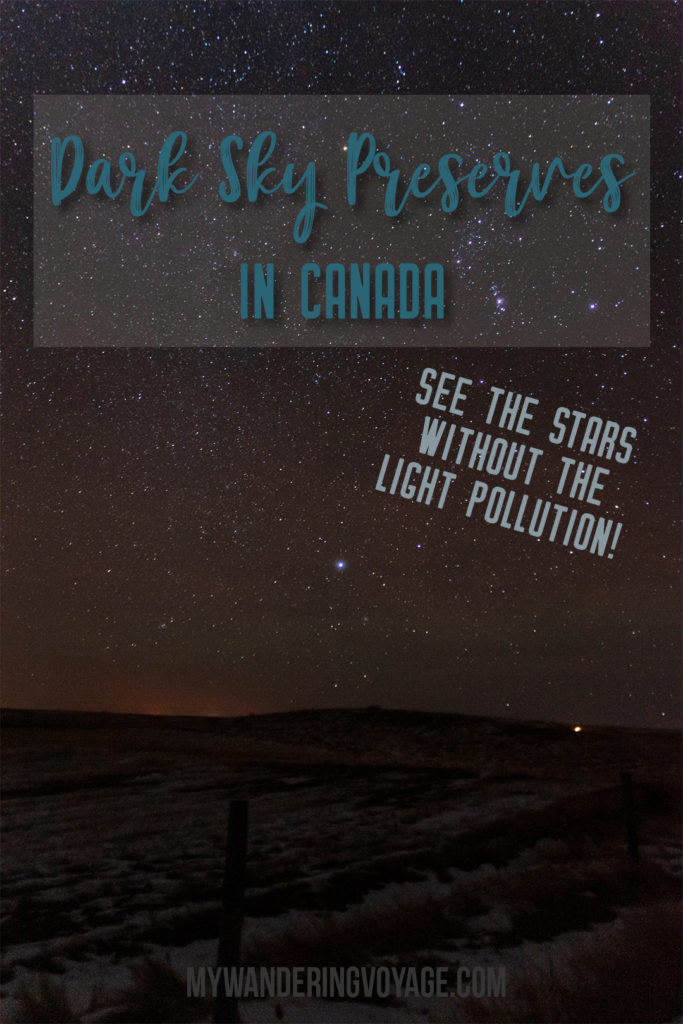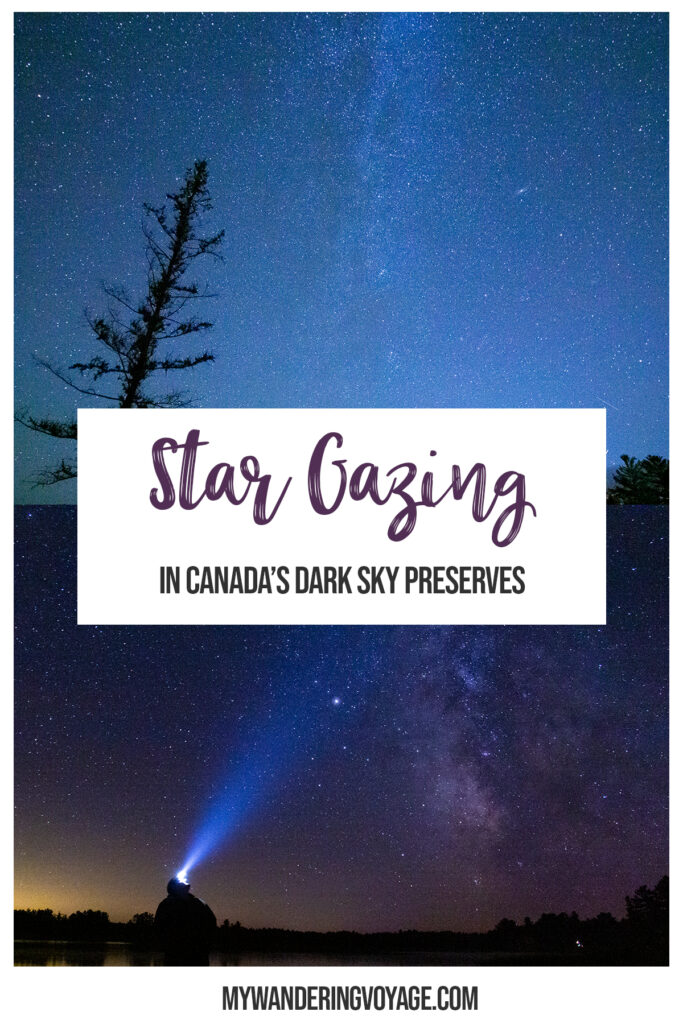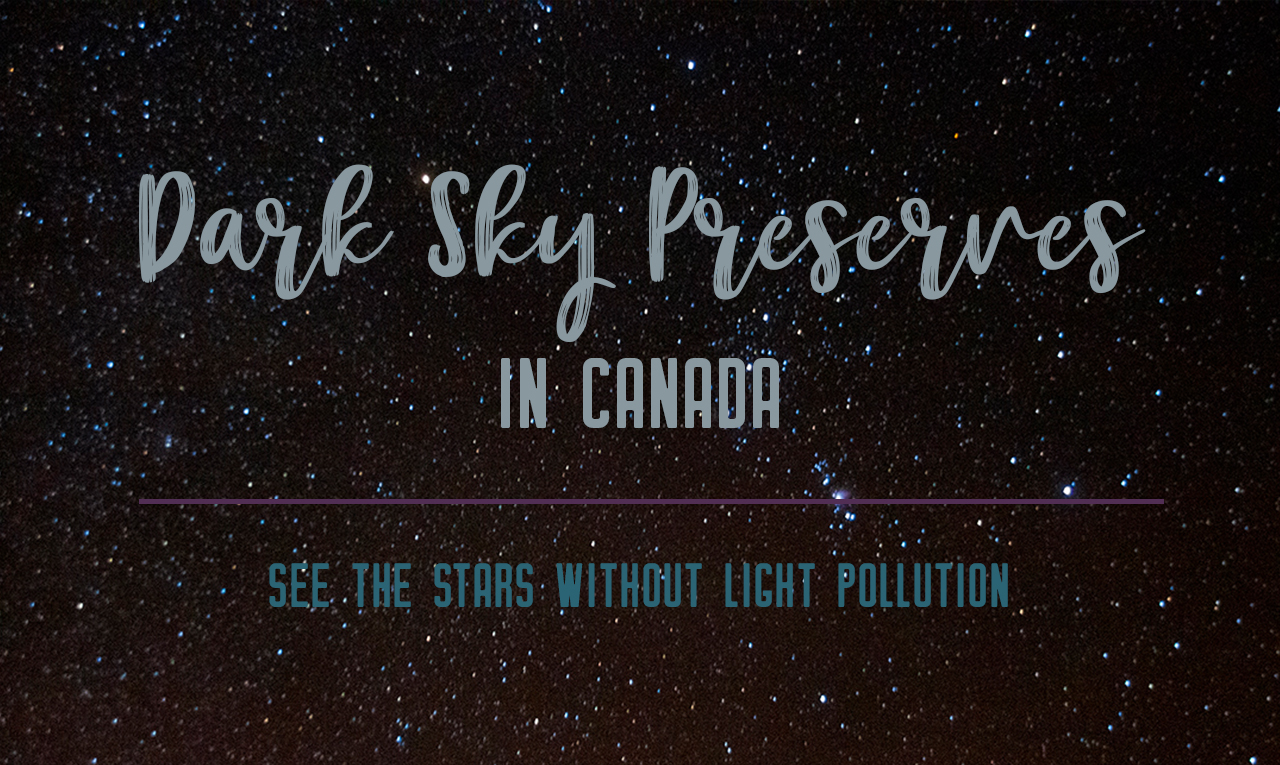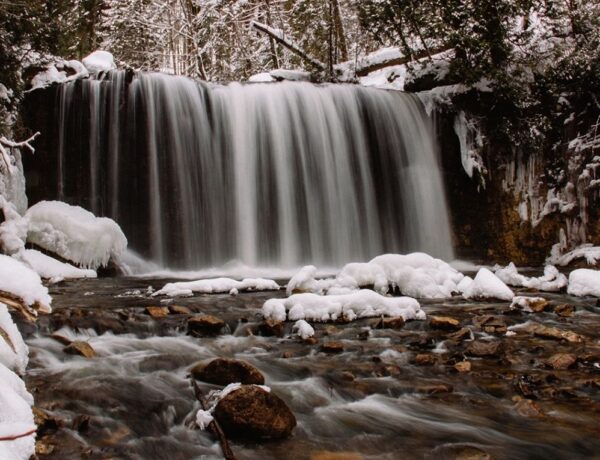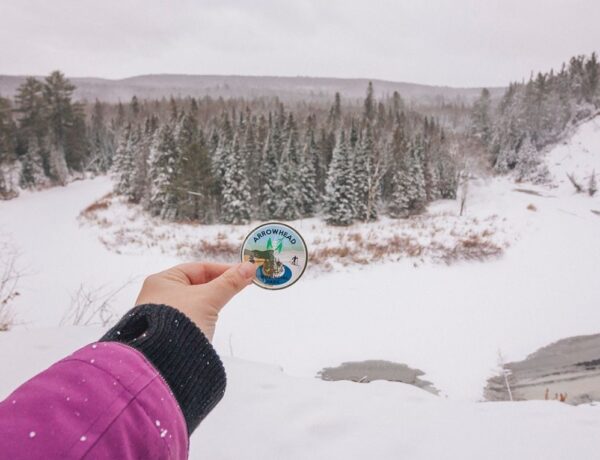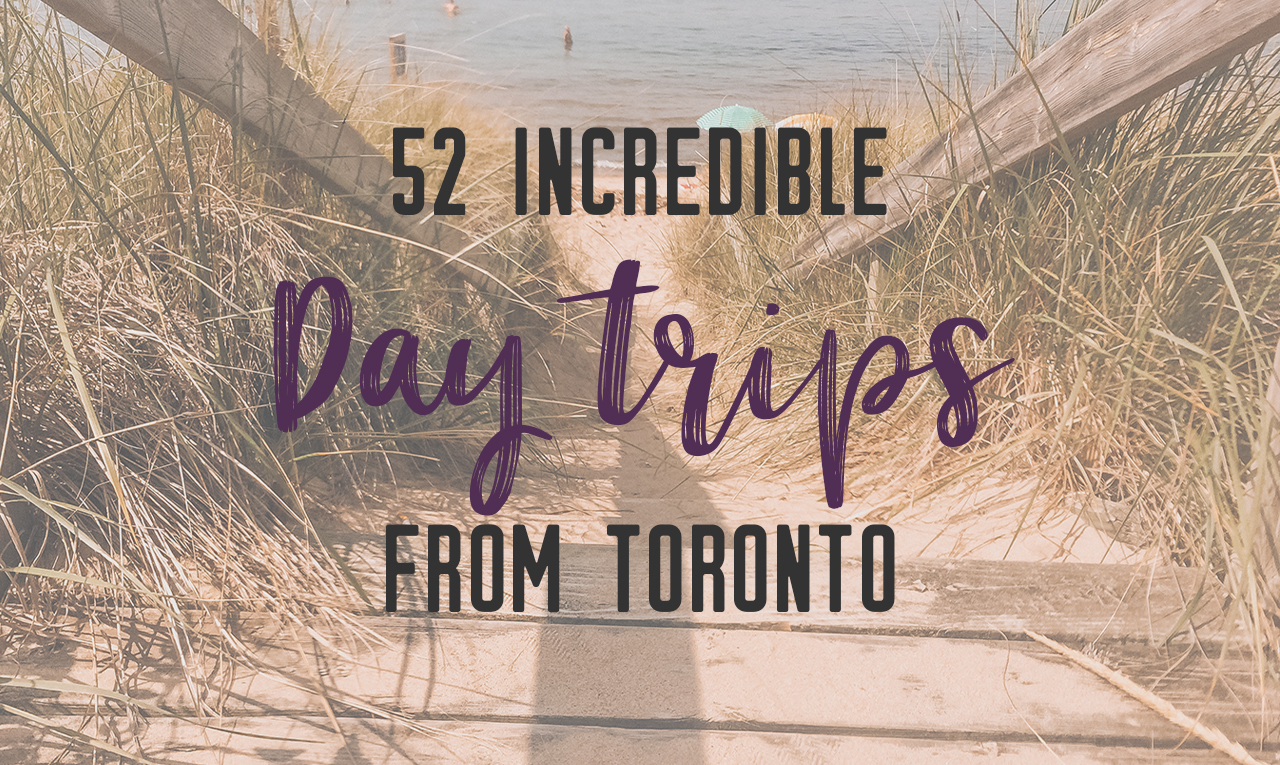What’s one new thing you would like to do this year? For me, I’d like to see and photograph more night time sky phenomenon, like the Milky Way and northern lights. The best way to do that is to visit one of the many dark sky preserves in Canada.
Hey there – this post likely contains affiliate links, which means I earn a commission (at no extra cost to you) if you purchase from them. This helps me earn a few dollars to run this website. For more info, check out my terms here.
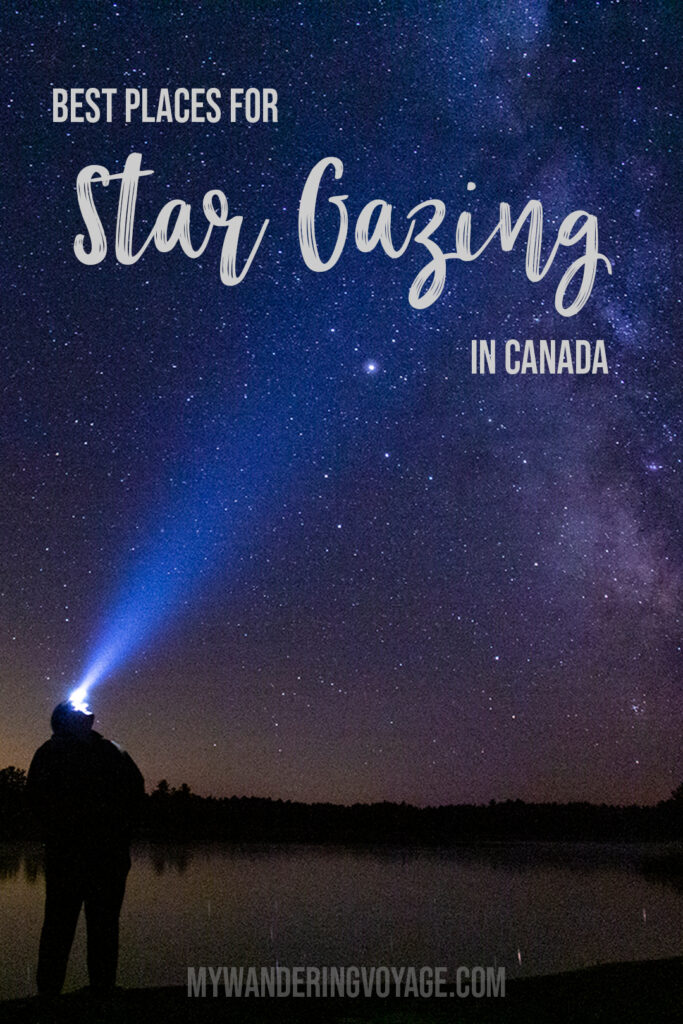
Have you ever stared up at the sky at night and tried to count all the stars you could see? As a child, I went to an overnight camp in Northern Ontario. At night, I remember looking up and being floored by the millions of stars that dotted the sky.
I’ve been pretty lucky. Growing up in the country, I’ve seen countless stars, meteor showers, eclipses and even the northern lights without leaving my property. Now that I live in the city, those viewing opportunities are few and far between.
With more than half of the world’s population living in cities, I’d bet that seeing a sky, utterly devoid of light except for the tiny balls of fire in the sky, is rarely done.
Lonely Planet has named dark skies a travel trend of 2019, saying “travellers are now seeking out the world’s last-remaining dark places where they can get a clear, unpolluted view of the stars.”
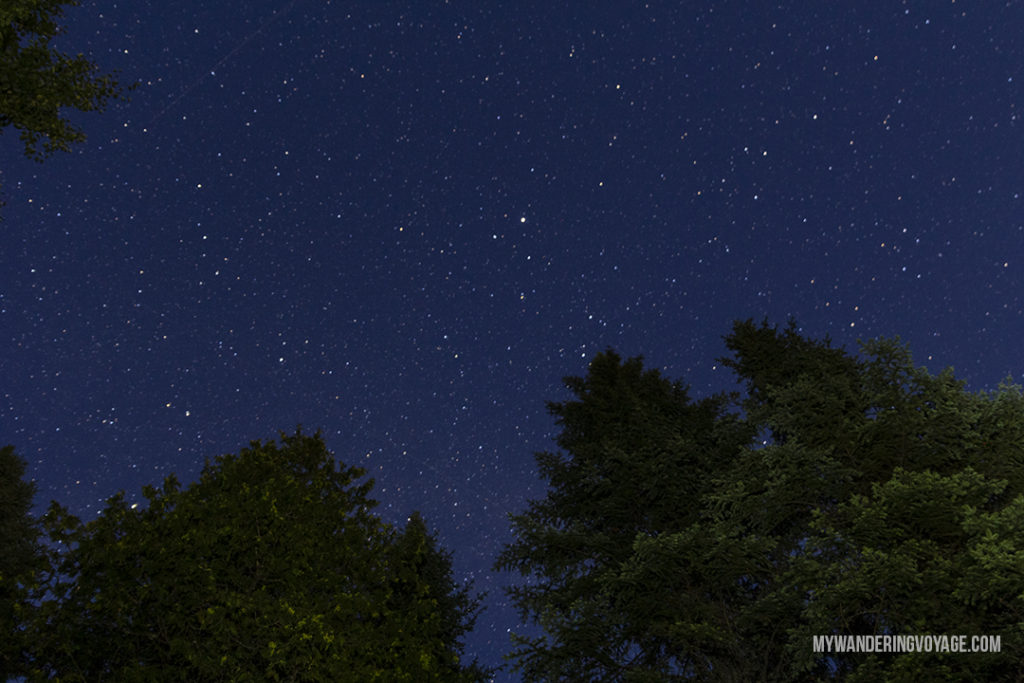
What are Dark Sky Preserves?
A dark sky preserve is usually a park that is far away from a city and restricts artificial light pollution. This allows the area to be sufficiently dark to allow for stargazing.
The overseeing regulatory body of these areas is the International Dark Sky Association, a US-based non-profit that advocates to “to preserve and protect the nighttime environment and our heritage of dark skies through quality outdoor lighting.”
Around the world, these dark-protection areas are known as dark sky preserves or dark sky reserves or even dark sky parks. While the International Dark Sky Association uses “reserves”, in Canada, the dark sky areas are known as “preserves” and are regulated and designated by the Royal Astronomical Society of Canada (RASC).
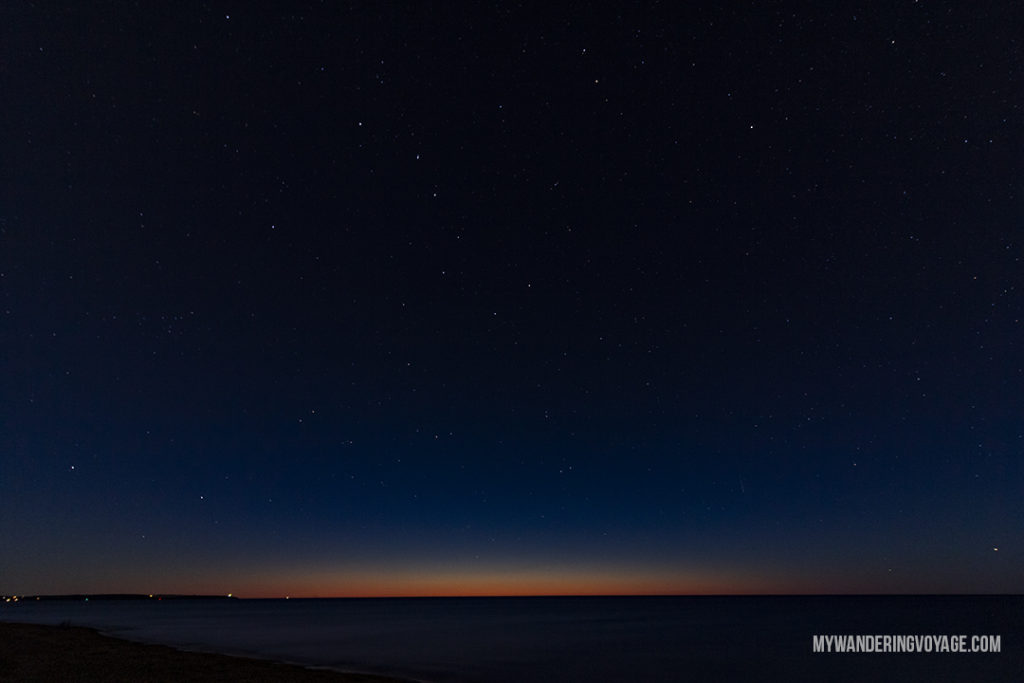
Why visit a dark sky preserve in Canada?
The first permanent dark sky preserve is located in the Muskokas in Ontario. And with the big swaths of land that have a tiny population, Canada is the perfect location for star-gazing.
The Royal Astronomical Society of Canada has three types of dark sky areas – a dark sky preserve, an urban star park and a nocturnal preserve.
According to their website, a Dark-Sky Preserve is an area in which no artificial lighting is visible and active measures are in place to educate and promote the reduction of light pollution to the public and nearby municipalities. Sky glow from beyond the borders of the Preserve will be of comparable intensity, or less, to that of natural sky glow.
An urban star park is an area of cities that artificial lighting is controlled allowing for the promotion of education of light pollution and astronomy. And a nocturnal preserve is primarily an area that protects the nighttime environment for wildlife, rather than for astronomical reasons.
There are 22 dark sky preserves in Canada, and many are only a few hours away from big cities, making them accessible to anyone who wants to visit.
Each of the dark sky preserves are given a number on the Bortle Scale – a measurement of the night sky’s brightness. The lower the number, the better. A class 1 is an excellent dark sky site, whereas a class 9 is an inner city sky.
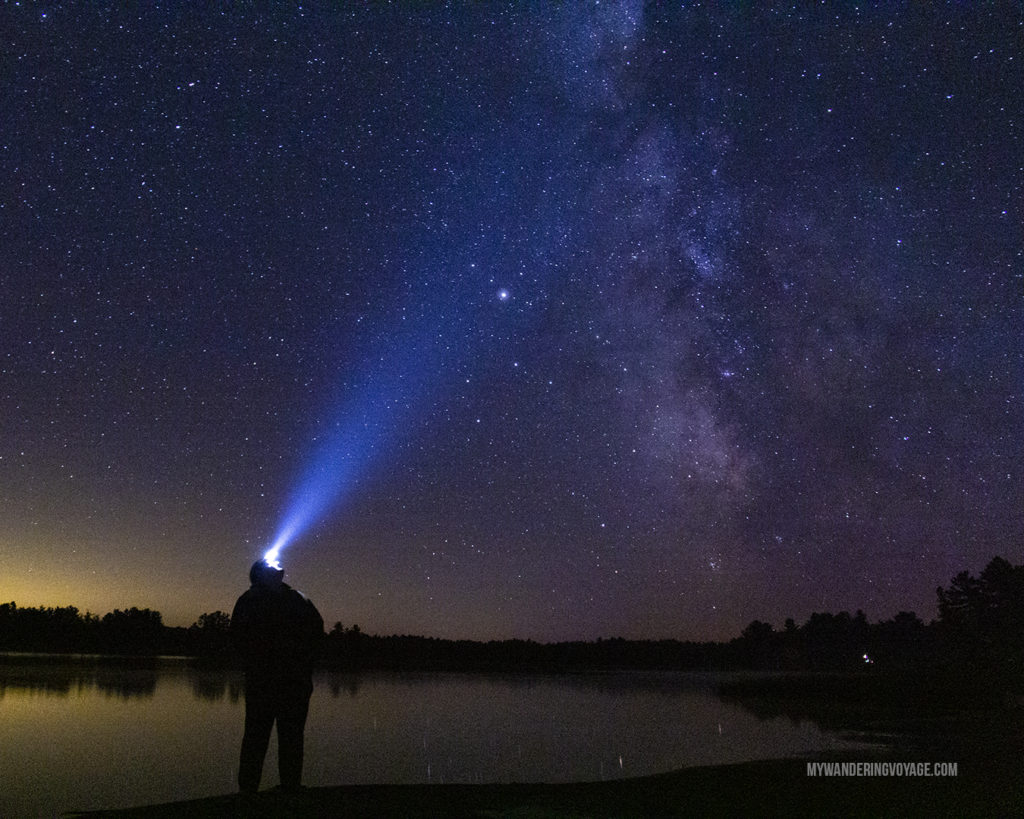
What do you need to visit a dark sky preserve?
A parks pass – many of the dark sky preserves in Canada are located within a national park. Why not also support Canadian parks and purchase a park’s pass for ease of access. Read up on Canada’s National Parks with this handy guide!
A camping chair – You’re going to want to get comfortable during your stargazing session, and a camping chair is the best way to do that and attend to your camera.
A blanket – If you’re more of the lay-down-and-gaze type of night sky enthusiast, a blanket is a much-needed addition to your gear. Open it up, and now you have the perfect place to lie down and let the stars put on a show.
A tripod – If you only bring one extra item for your astrophotography needs, then let it be a tripod. You won’t be able to take beautiful photos of the stars without it.
A red-light headlamp – It can take up to 30 minutes to get your night vision back after seeing a bright light, so use a red-light headlamp to reduce that time, and the red doesn’t disrupt your eyes as much.
Warm clothing – Even in the summer, nighttime in Canada can cool off quickly. Bring layers so you can cozy up and not worry about freezing your butt off while looking at the stars.
RELATED: What to Pack for Canada in Summer
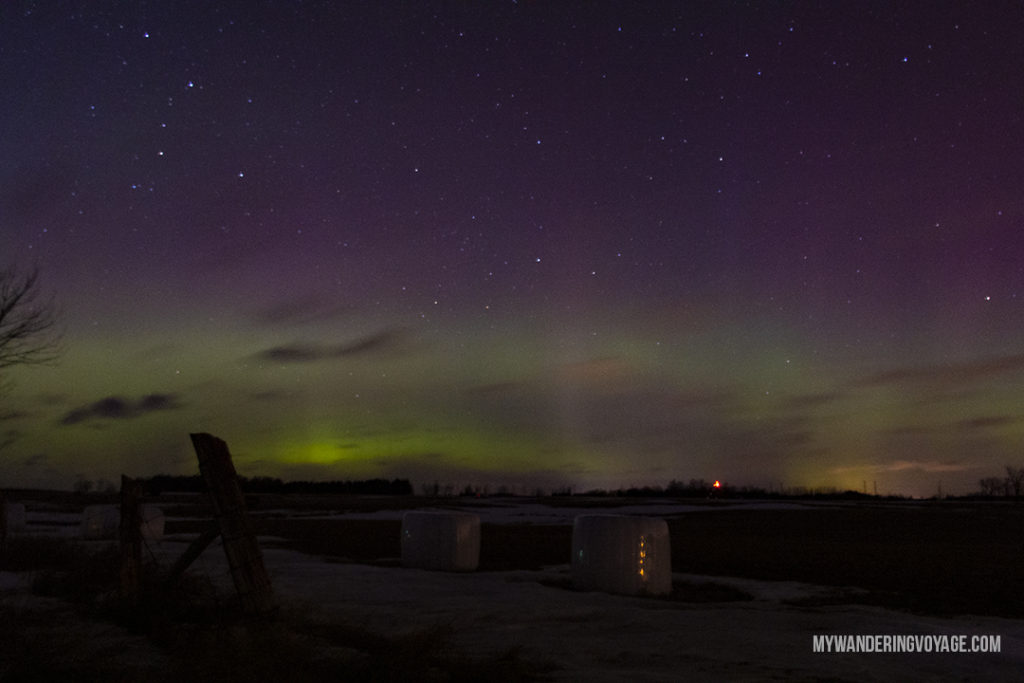
Taking photos of the stars
Astro-photography is arguably one of the hardest to do, and I don’t think I even have it down pat. That’s why I want to get out and take more night photos this year.
You’re going to need a stable tripod that won’t move or vibrate in the wind. An additional item you might want to consider is a remote shutter release, but a delayed shutter timer on your camera will also work.
Switch off auto-focus and set the focal length to infinity. Use a high ISO, like 1600, use a long shutter speed, like 30 sec, and open up your aperture to as low as you can. Then once you take a few test shots, adjust as needed.
A more in-depth resource from Backpacker explains the ins and outs of night-time photography.
British Columbia
McDonald Park Dark Sky Park, Abbotsford
The McDonald Park Dark Sky Park is located halfway between Abbotsford and Chilliwack, British Columbia. But the lights from either city are blocked by mountains, making this an ideal location to grab those night time shots.
The park is only open at night for events by the Fraser Valley Astronomers Society. It’s small, only five hectares, but it is rated 2/3 on the Bortle scale, meaning it’s great for star gazing.
Cattle Point, Uplands Park, Oak Bay
As an urban star park, Cattle Point allows nearby Victoria, BC residents to escape the glow and look up to see the stars. Cattle Point is located in Uplands Park, Oak Bay which is a short drive from British Columbia’s capital city, Victoria. Cattle Point is one of two urban star parks in Canada.
With a Bortle rating of 5, you’ll need a really clear night to see the stars. But Cattle Point is surrounded by darkness and the municipality has been working hard to improve the light pollution surrounding the area.
Related: Explore beautiful British Columbia in 10 days
Alberta
Beaver Hills, Elk Island National Park
Beaver Hills is a giant area just west of Edmonton and includes Elk Island National Park. The Beaver Hills moraine is a mix of boreal forest and depressional areas, many of which support wetlands, small lakes and streams. It’s a total area of 29,300 hectares and a 4.5 on the Bortle Scale, mostly due to the proximity to Edmonton and open, flat land that surrounds it.
Yet, Beaver Hills is a great place for stargazing, especially at one of the many lakes within Elk Island National Park – it makes for some stunning photos.
Every September, the Edmonton Centre Royal Astronomical of Canada holds its annual Star Party at Elk Island National Park with fun, music, entertainment and of course stargazing.
Jasper National Park
Jasper National Park might be one of the best places to go stargazing. Maybe I’m biased, but I adore Jasper National Park. The Rocky Mountains area is my favourite place in Canada.
Jasper National Park’s dark sky preserve is over a million hectares, and it’s a 1-2 on the Bortle scale, meaning it’s perfect for stargazing.
People gather here every October for the Jasper Dark Sky Festival, holding events with speakers like the Kelly Brothers, starlight excursions, art exhibits, photography workshops, and more.
Related: 10 places you must stop between Jasper and Banff, Alberta
Wood Buffalo National Park
Wood Buffalo National Park dark sky preserve is another excellent place in Alberta to look up at the stars. At nearly 4.5 million hectares and located in the northern part of Alberta, meaning there’s little to no light that can pollute the night sky.
The park is also a UNESCO World Heritage Site with the world’s largest freshwater river deltas and. Wood Buffalo is also the largest dark sky preserve in Canada and the world. At a 1-2 on the Bortle scale, it’s perfect for those picture perfect moments.
Every August, the park holds a Dark Sky Festival, where you can “come behold the mysteries of the universe” with camping and night time fun.
Waterton Lakes-Glacier International Peace Park
While not officially recognized yet as a dark sky preserve – Parks Canada is going through the steps to be certified – Waterton Lakes-Glacier International Peace Park is an awesome place to dip your toes into astronomy.
Already a UNESCO World Heritage Site and a shared national park with the USA, Waterton Lakes is working to reduce its night pollution and are starting to offer sky theatre programs as well as special events around the night sky.
Lakeland Provincial Park
In the central region of Alberta, just north of Edmonton is Lakeland Provincial Park. This dark sky preserve is a quiet spot to contemplate your place in the universe. It’s also a fantastic observation point for the Aurora Borealis.
Each September, Alberta Parks hosts the Lakeland Dark Sky Celebration where you can take part in activities and learn about the night sky.
Saskatchewan
Cypress Hills Interprovincial Park
Cypress Hills Interprovincial Park is situated on the border of Alberta and Saskatchewan near the southern portion of the two provinces.
The forested area makes a wonderful place to relax and take in the night sky. It’s rated 2 on the Bortle scale, so you know you’re going to get a great night sky.
The Royal Astronomical Society of Canada-Saskatoon Centre hosts a Summer Star Party each August, one of the largest gathering of stargazers in Canada. It was at this Summer Star Party in 2001 that amateur astronomer Vance Petriew discovered a comet – officially designated as Comet Petriew (P/2001 Q2).
Cypress Hills also has an observatory that opens Tuesdays, Thursdays and Sundays at 10 pm.
Grasslands National Park
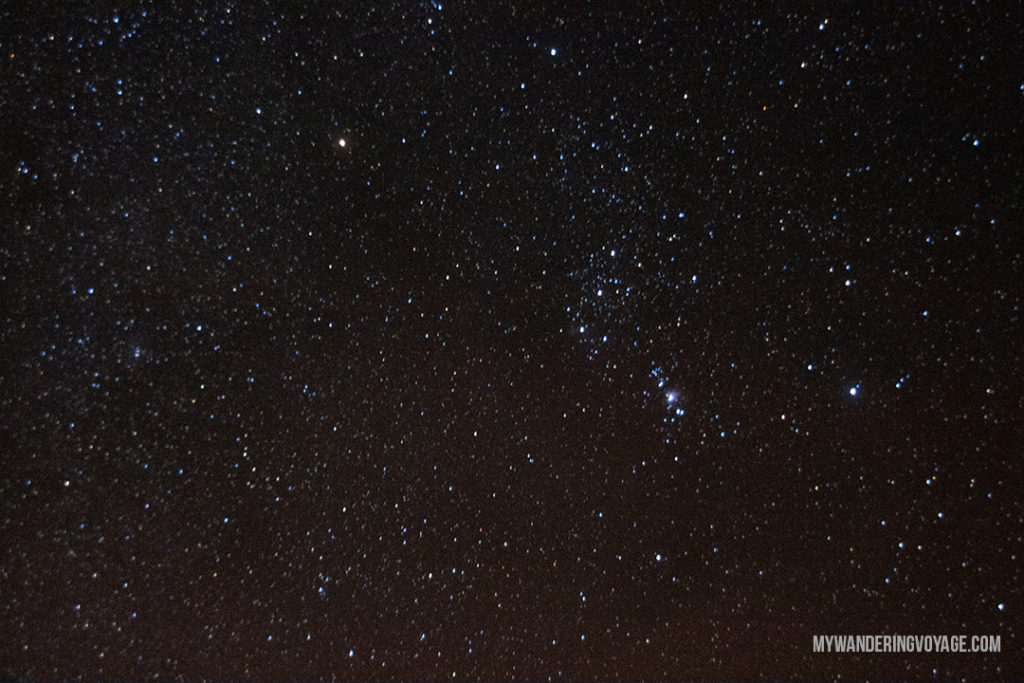
You might have heard that I am a big fan of Saskatchewan, and the far-reaching flatlands, mean that the sky seems more significant here. Saskatchewan is known as the land of living skies, and at night, you can really feel it.
At Grasslands National Park, you can take in the spectacle of the night sky in one of the most beautiful national parks in Canada.
Grasslands is the only national park in Canada dedicated to the prairies, and Parks Canada has dedicated the entire park to preserve dark skies. Here you can find some of the darkest skies in Canada.
I can attest to the absolutely surreal feeling of staring at the stars at night, something you’ll want to experience yourself.
Related: Why you should explore Saskatchewan
Ontario
Bluewater Outdoor Education Centre
Started by amateur astronomers, the Bluewater Outdoor Education Centre in Port Elgin, which is about 2.5 hours from Toronto on the shores of Lake Huron, is great for first timers
The Bluewater Astronomical Society operate ES Fox Observatory, which is open to the public on public viewing nights. While it is a small area, it still has dark skies perfect for a night of stargazing.
Bruce Peninsula National Park and Fathom Five National Marine Park
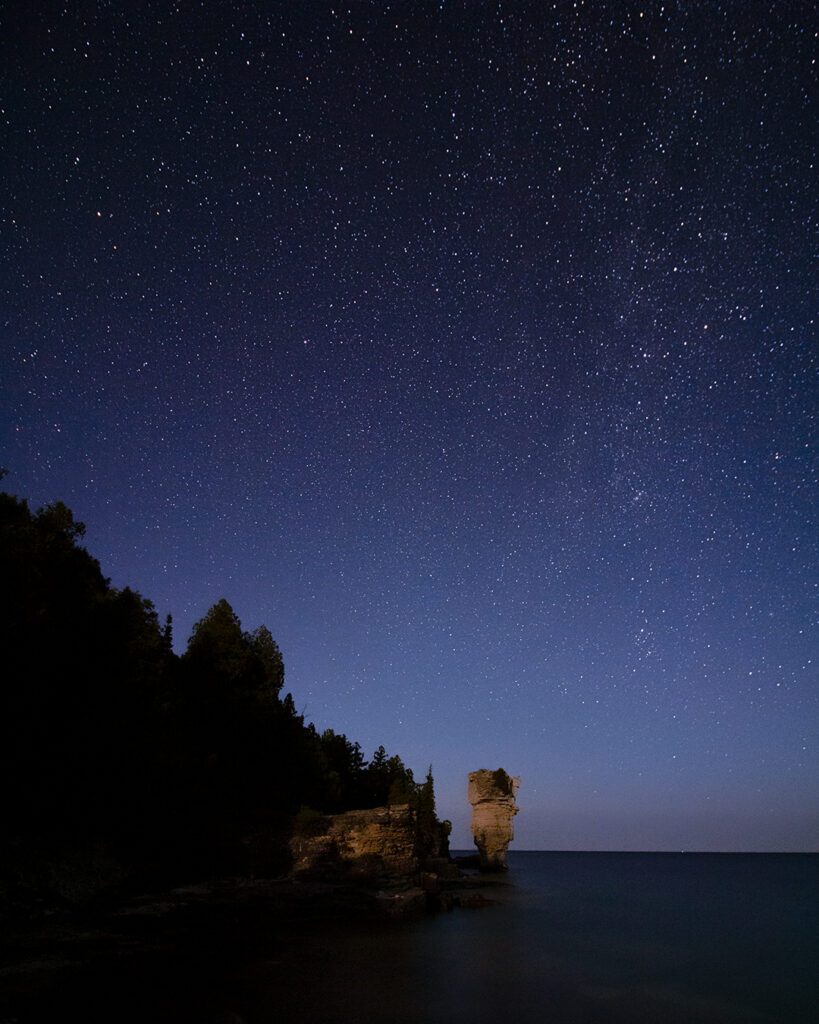
As the sun sets over the geological marvel of Bruce Peninsula National Park and Fathom Five National Marine Park, it opens up a whole new sky above.
This area offers a spectacular view of the night sky over Georgian Bay.
Every Friday and Saturday night in the summer months, the Bruce Peninsula Biosphere Association hosts astronomy nights. Climb the Peninsula Observation Tower to get an incredible 360-degree view of the sky.
This place is a refuge for night sky seekers and adventure seekers – be sure to be careful around the cliffs.
RELATED: The Complete Guide to Tobermory and Flowerpot Island Camping
Gordon’s Park
Manitoulin Island is home to Gordon’s Park, a dark sky preserve known for its spectacular night sky viewing.
You can camp here or stay in a tipi, cabin or bed and breakfast. Since it’s far away from any city, this place was built for stargazers.
Gordon’s Park offers astronomy nights every Thursday and Saturdays in the summer as well as stargazing hikes every Friday. Twice during the summer, they host star parties and aurora borealis viewing weekends.
North Frontenac
Two hours from Ottawa and four hours from Toronto, North Frontenac is a great place to visit for newbie stargazers. There is an observation pad located near Plevna, which is the best place to stargaze in the area.
On Aug. 3, 2013, it became the first municipality to receive the dark sky designation.
Point Pelee National Park
While most dark sky preserves in Canada mean driving north, at Point Pelee National Park, you’ll be heading to the furthest south area of the country.
This park consists of marshland, beach and forests. Did you know that the point of Point Pelee actually moves? Since it is made with sand, the tip moves with the wind and waves.
Birders flock to the area during daylight hours to watch the millions of birds who stop here on their migration. That’s why Point Pelee was protected as a national park. That protection expanded in 2006 when it became a dark-sky preserve.
The park is typically closed during the evening, but every night during the new moon, the park stays open until midnight for stargazing experiences.
Torrance Barrens
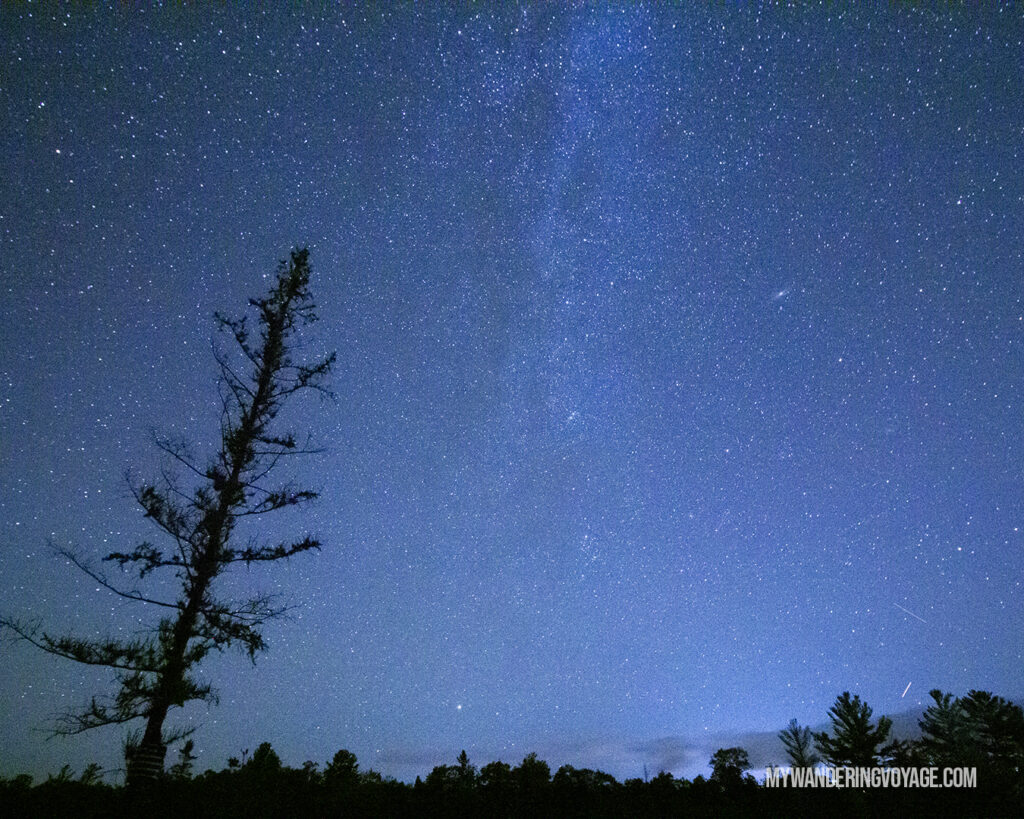
Torrance Barrens near the Muskoka region of Ontario was the first dark sky preserve in Canada. This area is also a conservation reserve and is surrounded by undeveloped land. Here you can admire the tapestry of stars as it was meant to be seen.
The rocky outcrop gives a stunning vista while the sun sets and you get ready for the show.
It is here that star-gazers can faintly see the Andromeda Galaxy with the naked eye.
Killarney Provincial Park
Killarney Provincial Park, located on the shores of Georgian Bay, is one of four new dark sky preserves in Canada added in 2018. It’s also one of two provincial parks in Ontario that has an observatory.
In 2018, the park added a research-grade telescope. During the summer they offer drop-in star-gazing nights with guest astronomers. The park also provides a self-use program during the summer where individuals can “sign out” the observatory for the night. Staff will instruct you how to use it, and you’re off. Don’t forget to log your observations.
Lake Superior Provincial Park
Lake Superior Provincial Park already feels like you are in the heart of the wilderness, with any signs of civilization far away. That’s what makes it the perfect place to set up a chair and watch the night sky unfold.
It is one of the four newest dark sky preserves in Canada after it was officially designated in 2018. And because of its northern location, it’s a great spot for trying to catch the Aurora Borealis.
The observing area is on the beach at the Agawa Bay Campground, but there are other great locations within the park.
Related: Winter Camping at Silent Lake Provincial Park
Quebec
Mont-Mégantic Dark-Sky Preserve
The Mont-Mégantic area is the only internationally recognized dark sky preserve in Canada. The Observatory is one of the largest in Eastern Canada and is owned by the University of Montreal.
While it is dedicated to astronomy research and closed to the public most nights, the observatory is open for viewing during the Festival d’astronomie Populaire du Mont-Mégantic held over nine nights in July.
Here you’ll be able to see the sky like no other place in Canada.
Au Diable Vert
This private campground located in the Appalachians of Quebec is a new dark sky preserve. Hosted by National Geographic’s Observe Etoiles, it’s the “world’s first open-air augmented reality planetarium.” What does this mean?
Well, every guest gets an augmented reality headset that allows them to see the night sky, with a digital overlay of constellation lines and names. These events are held every Tuesday and Saturday during the summer months.
Astronomers guide the events, held in the camp’s open-air auditorium. This is one of the coolest night sky observatories I’ve seen yet!
Related: Get the most from a three-day Montreal itinerary
New Brunswick
Kouchibouguac National Park
Located on the eastern shores of New Brunswick, Kouchibouguac is a pretty diverse national park. From the towering trees to the sand dunes and salt marshes, this is one neat place to explore.
At night, the park comes alive with the majestic sky ablaze with stars. It’s why Sky News called it “one of the most magical astronomy parks in North America.”
Every Tuesday from June to August, the park staff put on a “legends of the night” event where you can learn about the night sky and the constellations held there.
They also hold a Spring and Fall Star Fest as well as a 10k under 10 Million Stars charity run, held at night.
Mount Carleton Provincial Park
Mount Carleton Provincial Park is a hiker’s paradise, but it also is a wonderful place for night-sky enthusiasts can get their fill of the stars.
Located in a remote area of northern New Brunswick, the park is perfectly pitch black for stargazing.
In August, the Royal Astronomical Society of Canada – New Brunswick Centre holds its annual Star Party at Mount Carleton where you can learn all about the night sky wonders.
Fundy National Park
Fundy National Park is a drop-dead-gorgeous park on the southern coast of New Brunswick. I’m a huge fan of the park, especially because there is a feeling of remoteness yet it continues to be accessible for all.
Here you’ll find the highest tides in the world, covered bridges, superb waterfalls and a stunning setting for stargazing.
Irving Nature Park, Saint John
For any city dweller, going out to see the stars can be difficult. Irving Nature Park is located just south of Saint John in New Brunswick, following 11 kilometres of rugged coastline.
The highest point is the Lookout Tower, where you’ll find the perfect spot to stargaze.
Related: 10 treasures to discover in New Brunswick
Nova Scotia
Kejimkujik National Park
The Kejimkujik National Park, located on the southern shore of Nova Scotia, is also a national historic site with deep ties to thousands of years of Indigenous culture.
This is one of the best National Parks in Canada to experience the dark sky. The staff pulled all the stops with dark sky weekends, night hikes, guided journeys and dark sky kits.
The dark sky kits can be rented each day and include binoculars, a star finder, red lights, games and references for stargazing.
The events run from May to September.
Related: Visit Lunenburg and other Nova Scotia UNESCO sites
Newfoundland and Labrador
Terra Nova National Park
One of the newest dark sky preserves in Canada, Terra Nova National Park is also the most eastern.
Here you can take advantage of the Night Sky Kits that include binoculars, star finder guide, moon gazer guide and more to really explore the stars.
The park will soon offer night watch walks to explore the nightlife of the surrounding wilderness. In August, the park will commemorate its dark sky designation with a Night Sky Celebration, where you can learn everything there is about the stars.
Canada Dark Sky Map
Now that you’ve read all about the dark sky parks in Canada, I’ve plotted them out on a map for you so you know exactly how close they are to you!

Whether you’re out a night to marvel at the beauty of the universe or to take stunning astrophotography, you’ll find your perfect stage and one of the many dark sky preserves in Canada.
Inspired? Pin it:
